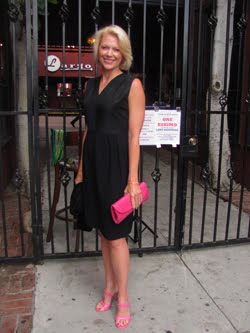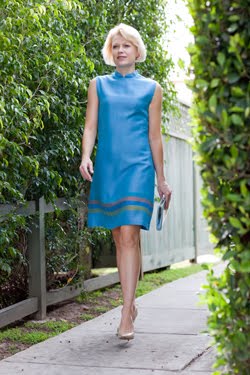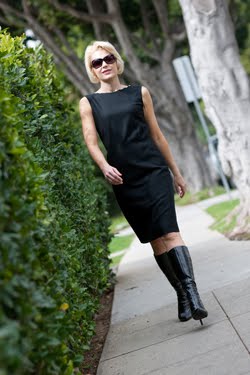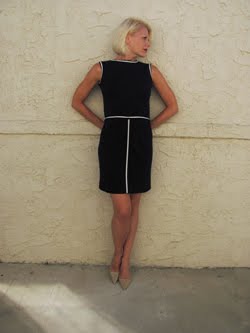Though much has been written about Katharine Hepburn's film career, surprisingly little has been dedicated to 1938's Holiday. It was directed by the great George Cukor, her longtime friend and the man behind 10 of her most memorable movies, including her debut in A Bill of Divorcement (1932). Holiday was their fourth picture together and the one right before the real turning point of her career--The Philadelphia Story (1940). In many ways, Holiday made that play and subsequent movie possible, and presented Kate to the world in a role that many critics now consider "archetypal" Hepburn. One can certainly see it in the strength and vulnerability of the character as well as her style. And like The Philadelphia Story, the origins of Holiday and the evolution of the Hepburn persona both begin on Broadway.
Holiday was first seen as a play in 1928, which Phillip Barry wrote with his friend Hope Williams in mind. Hope was an heiress who "shocked her aristocratic family when she took to the stage" after encouragement from Barry and another friend. Similarly, Holiday's lead character of Linda Seton longs for independence from her family, one where money seems to be its master, and it's someone outside the Setons who finally inspires her to strike her own path. Once Hope found her own path, she was a great success on Broadway. She was unique as an actress--"a skinny, androgynous New York society girl with close-cropped taffy-colored hair, a crooked smile, and an emphatic arm-swinging stride." That flat-footed walk along with her dead-pan delivery endeared her to audiences and announced a new kind of star on the stage. Everything about her seemed to be polished and effortless.
Someone who was fascinated with the "Park Avenue Swagger Girl" was her Holiday understudy--Katharine Hepburn. Kate was young and relatively inexperienced, not to mention "too 'fresh and perky' for her own good." She found she could never quite connect with co-stars who all went to the same finishing school and seemed to speak their own language. Hope and her friends were determined to keep Katharine off the stage; Hope even performed with a horrendous case of the flu. As a result, Kate went on only once in all of Holiday's 229 performances. That one time was quite enough. Instead of playing the part of Linda Seton, she found herself trying to imitate Hope Williams and became "conscious of getting no response to lines that usually elicited peals of laughter." It was an "unsettling experience" for the young actress.
As a result, Kate's vocal coach Frances Robinson-Duff introduced her to Laura Harding. Harding was another heiress whose father, Chairman of the Board for American Express, left her millions. She, like Hope Williams, had gone to finishing school and appeared in amateur theater before trying to make it a career. Laura and Kate became fast friends--becoming roommates in a theatrical boarding house a la Stage Door, performing in summer stock at the Berkshire Playhouse, sailing to Mexico for Hepburn's divorce, moving to Hollywood, and then living together there. Before the start of their relationship,
Kate was brash, spontaneous, and unconventional. Laura, sleek and impeccably tailored, always knew the thing to do; she knew what good taste was all about. Where Kate's "impossible" gravelly voice cracked and squeaked with unrestrained excitement, Laura spoke in low, carefully modulated tones.
It's not that Kate didn't have her own dignity and grace, and it wasn't that she didn't have a wonderful upbringing in Connecticut and an enviable education at Bryn Mawr. But she was often aloof, more than a bit bohemian in her behavior and appearance, and definitely had a few "rough edges." But after her relationship with Laura and all that time spent studying Hope Williams "as though she was a part in a play," no one west of New York could tell the difference between Kate and true society girls. In fact, the transformation was so successful that even the Hollywood press circulated rumors that she, too, was an "heiress to untold millions."
Heiress Hope Williams playing Linda Seton in Holiday on Broadway (above)
American Express heiress Laura Harding (above left) with Kate and others during summer stock,
and together at the NY airport before heading to Miami and then Mexico for Hepburn's divorce
Hepburn had some challenges to deal with first. Today we may look on her as one of the greatest actresses of all time, but in the late 1930s she was really struggling in Hollywood. This was not long before the Theater Owners of America published a list of actors they considered "Box Office Poison" and included Kate on the list. RKO had such little faith in her that they were set to cast her in a film with the unfortunate title Mother Carey's Chickens (a real production that got made with Anne Shirley and Ruby Keeler). It would have been her last film with RKO, so Kate decided to buy herself out of her contract for $75,000 rather than succumb to that horror. She then allowed herself to be loaned out to Columbia to work with Cukor on Holiday.
Despite Cukor's endorsement and the fact that she had won an Oscar for Morning Glory (1933), she was not who the studio really wanted. Irene Dunne was their first choice (due to her recent success The Awful Truth with co-star Cary Grant), and there were others such as Joan Bennett and Ginger Rogers who were of interest. But there's no question that Kate really had the edge, especially considering her extensive experience with the play and years spent studying the upper class. This time, when presented with the role of Linda Seton, she knew exactly how to play the part. And with it, she would put the finishing touches on the Hepburn persona.
Not only was the character now perfect for her, but she would work with a costume designer who really understood her aesthetic as well. That's not to say Kate hadn't worked with supremely gifted costume designers before; in fact, she had just worked with Howard Greer, formerly Paramount's head of costume design, on Bringing Up Baby (1938). But to my mind, Holiday is where we finally get a sense of what would be known as Hepburn style and that's due to the talent of the great Robert "Bobby" Kalloch.
Kalloch sketching in his office at Columbia (above)
and discussing fabric with Ida Lupino
Kalloch was highly skilled as an artist. After his time at Parsons, he joined the prestigious Lucile couturier. He started as a sketch artist and then quickly progressed to dress designer. Lucile was a great source of talent for the film industry; several other great costume designers, notably head costume designers, came from the house of Lucile--Howard Greer (Paramount), Travis Banton (Paramount), and Vera West (Universal). Kalloch was particularly renowned in his time, designing custom-made high fashion for royalty, the social elite, and revue stars. At the height of his international fame, Kalloch was invited to head Columbia's costume design department by Harry Cohn, who was hoping to improve the reputation of his "Poverty Row" studio. Kalloch would do just that and be known for iconic work on films like It Happened One Night (1934) and His Girl Friday (1940)--both on the list of The Style Essentials on GlamAmor for their influence on fashion both then and now. Kalloch would work at Columbia for nearly a decade before joining MGM in the early 1940s just as his friend Adrian was about to say goodbye to the studio forever.
Not only is Kalloch a brilliant designer, but he communicates so much about the characters of Holiday's Seton sisters without them even uttering a word. Julia is clearly very feminine, loves dressing up and showing her wealth through jewelry and fur. Linda, in comparison, leans toward the tom-boyish and is much more comfortable in simple separates, like blouses and skirts. She might own a fur coat, but it is worn in a very casual manner. Even her evening gown at the family's grand New Year's Eve party is subtle in its elegance and contrasts with everyone else. That longsleeve gown happens to be a great example of how Kalloch's clothes for Linda Seton reflect some of what we now know to be Katharine Hepburn style as well.
Holiday is a true transition moment for Katharine Hepburn. In one respect, it is the culmination of all she learned leading up to that point from her years in the theater and then in early film at RKO. In another respect, it is the starting point for the rest of her career; it is right before she returns to Broadway to The Philadelphia Story (written specifically for her by Holiday's Phillip Barry), and then bringing that play back to Hollywood to start a successful career at MGM. The persona she crafted for herself, both onscreen and off, has much of its origins tied to Holiday. And thanks to costume designer Kalloch, it is also a testament to her style and the foundation of what other designers, like Adrian, would build upon. Kate's performance--along with co-stars like Cary Grant, Lew Ayres, and Edward Everett Horton (who also played Nick Potter in 1930's Holiday)--is, of course, terrific and the story is surprisingly relatable today. If you haven't seen it before, I encourage you to do so. And if you have already seen it, I encourage you to take a fresh look at its style. All hail, the Great Kate.
New York City's Park Avenue
Johnny Case (Cary Grant) arrives as the home of his new love Julia Seton,
and is both confused and blown away by the grandeur in which she lives
These shots of the interior of the Seton mansion shows just why the
art direction by Stephen Goosón and Lionel Banks was nominated for an Oscar
The first of the Seton family we meet is Ned (Lew Ayres),
the kind but neglected son who frequently turns to alcohol to escape
Next we meet his fiancée Julia (Doris Nolan) looking every bit the debutante in her Kalloch ensemble
complete with large fur muff and triple-strand of pearls
Next we meet Ned and Julia's sister, Linda Seton (Katharine Hepburn), who is also dressed in fur
but there is something more sensible about her separates underneath
When Johnny returns to meet the patriarch of the family and ask for Julia's hand in marriage,
he finds Linda in a room--part living room, part playroom--that's very different than the rest of the house
Linda might compare herself to her favorite childhood toy,
but she is clearly very beautiful in an understated way
Kalloch does a great job at distinguishing the sisters in their costumes--
Julia loves dresses and being adorned with jewelry versus Linda who loves separates like this blouse and skirt
Julia in Kalloch's beautiful silk night clothes to ask her father (Henry Kolker) for permission to marry...
it's interesting that then starlet Rita Hayworth tested for the part of Julia, but was judged too inexperienced
it's interesting that then starlet Rita Hayworth tested for the part of Julia, but was judged too inexperienced
A lavish New Year's Eve party is thrown to announce the engagement...
a large party that was much against Linda's wishes, who wanted to throw her sister a smaller affair
Linda takes refuge in the playroom away from the mayhem of the event
as do Johnny's best friends Nick and Susan Potter,
played by the great character actors Edward Everett Horton and Jean Dixon
played by the great character actors Edward Everett Horton and Jean Dixon
This trick shows both Cary's experience from his days in vaudeville
as well as Kate's natural daring and love of anything physical
This might be my favorite gown of Kalloch's--longsleeve, crew-neck, and seemingly simple
with a narrow open back--and exemplary of what would be known as Hepburn style
Another gorgeous gown of Kalloch that is perfect for the character of Julia--
shiny metallic, perfect for a New Year's Eve party, with slim straps that split around an open back
Note that underneath her sleek gown, Kalloch has included a surprising ruffled petticoat
that is exposed when the two dance together
I also adore this Paul Flato diamond necklace that Kalloch used to accessorize the gown
along with a brooch to pin a chiffon scarf to the front to add a little detail
Though Hepburn is known for her partnership with Spencer Tracy,
she had incredible chemistry with four-time co-star Cary Grant
Happy New Year!
Though the engagement is finally announced, one can see that Johnny is no longer happy about it...
nor is Linda, who slowly descends the stars from the playroom to join the party
Gorgeous full-length view of my favorite gown from Holiday
Johnny tries to uphold his own vision of the future--taking a holiday after years of working successfully to find the meaning of his life--
but is abandoned by Julia
Concerned, Linda approaches the Potters who are now her friends as well...
once again in sensible separates that include a checked blouse
After looking in vain for Johnny, Linda now approaches Julia to help sort things out
Once again, Kalloch shows us the dramatic contrast between the sisters in their costumes--
Julia in a highly feminine evening gown with floral centerpiece...
...and Linda in more subtle longsleeve dress
but with marvelous detail at the shoulder and another slit of an open back
As Johnny arrives for the final showdown, note how much his own look has evolved...
from a baggy ill-fitting suit with a bowtie in the opening scenes to tuxedo with tails to this tailored suit
With the engagement to Julia broken, the Seton family says good-bye to Johnny
As Linda says so long, we can see Kalloch's brilliance in her high-neck dress--
fabric is pinned over her shoulder with buttons and another brooch
Also note the big bracelet--sized to be seen on screen--
and her pinky ring, which was Kate's favorite piece of Paul Flato jewelry from the film
As the ship prepares to sail, Johnny performs an acrobatic flip-flop to celebrate the journey
just as Linda decides to leave her family behind to join them
It's bon voyage for Johnny and Linda and a wonderful holiday together
Sources
D'Arminio, Aubry. "Katharine Hepburn in Diamonds and Platinum from Paul Flato and Fulco di Verdura." JCK magazine. June 2014. Web. 1 January 2015. http://www.jckonline.com/2014/05/26/katharine-hepburn-in-diamonds-and-platinum-from-paul-flato-and-fulco-di-verdura
Dooley, Roger. Scarface to Scarlett: American Films in the 1930s. New York: Harcourt Brace Jovanovich, 1981.
Hepburn, Katharine. Me: Stories of My Life. New York: Alfred A. Knopf, 1991.
"Holiday." American Film Institute. Web. 1 January 2015. http://www.afi.com/members/catalog/DetailView.aspx?s=&Movie=4592
"Holiday." TCM.com. Web. 1 January 2015. http://www.tcm.com/tcmdb/title/209/Holiday/notes.html
Dooley, Roger. Scarface to Scarlett: American Films in the 1930s. New York: Harcourt Brace Jovanovich, 1981.
Hepburn, Katharine. Me: Stories of My Life. New York: Alfred A. Knopf, 1991.
"Holiday." American Film Institute. Web. 1 January 2015. http://www.afi.com/members/catalog/DetailView.aspx?s=&Movie=4592
"Holiday." TCM.com. Web. 1 January 2015. http://www.tcm.com/tcmdb/title/209/Holiday/notes.html
Lambert, Gavin. On Cukor. New York: Rizzoli International Publications, Inc., 2000.
Leaming, Barbara. Katharine Hepburn. New York: Crown Publishers, Inc., 1995.
Leese, Elisabeth. Costume Design in the Movies. New York: Dover Publications, Inc., 1991.
Mowis, I. S. "Robert Kalloch." IMDb. Web. 1 January 2015. http://www.imdb.com/name/nm0436056/
Nemy, Enid. "Paul Flato, Jeweler to the Stars On Screen and Off, Dies at 98." New York Times. 23 July 1999. Web. 1 January 2015. http://www.nytimes.com/1999/07/23/arts/paul-flato-jeweler-to-stars-on-screen-and-off-dies-at-98.html
Leese, Elisabeth. Costume Design in the Movies. New York: Dover Publications, Inc., 1991.
Mowis, I. S. "Robert Kalloch." IMDb. Web. 1 January 2015. http://www.imdb.com/name/nm0436056/
Nemy, Enid. "Paul Flato, Jeweler to the Stars On Screen and Off, Dies at 98." New York Times. 23 July 1999. Web. 1 January 2015. http://www.nytimes.com/1999/07/23/arts/paul-flato-jeweler-to-stars-on-screen-and-off-dies-at-98.html
Photos
Screen shots by Kimberly Truhler for GlamAmor
Additional photos courtesy of Doctor Macro and Kalloch.org
Screen shots by Kimberly Truhler for GlamAmor
Additional photos courtesy of Doctor Macro and Kalloch.org





















































































































































8 comments:
I always learn so much when I read your articles, Kimberly, but this one wins a gold star, I think because it speaks of someone who isn't so well known. What a wonderful study of some gorgeous clothes. I LOVE Kate's style in this one and it makes me yearn to have some of those gowns...always a good sign that someone has done her/his designing job well. HUGELY entertaining and educational, my friend!
This is one of my fave Kathatine Hepburn roles – I think she's exceedingly good in this film.
Thank you for posting this background info about Hope Williams and how the movie came to be.
Time to see this again, with all these points in mind. It'll be like watching it again for the first time!
Great post Kimberly - very informative and a great selection. This is one of my favorite films too. For the fashions and for the great acting all the way around. Every actor seems perfect in their role - such wonderful character actors as Edward Everett Horton, and I think in his best role, Lew Ayres.
Katharine was already a great actress, but this movie gave her her style as you point out.
Thank you, Kay. Appreciate the kind words and glad you enjoyed it so much. This film has quite a backstory to it, including its style, and it's amazing how little it's all discussed. I enjoy sharing what I know and have learned. It's fascinating to me.
I'm so glad you enjoyed the info on Hope Williams, Ruth. We all assume that Katharine Hepburn came to us fully formed, but even she had influences and went through an evolution. Fascinating to learn who those people were in her life that were so inspiring. I love that you're excited to watch it again!
Thanks so much, Christian. I thought of you when I wrote it because I know you, too, have celebrated Kalloch on your SILVER SCREEN MODES. You're so right about the actors--every one is simply perfect in his or her role, and that's a huge part of making the movie so good. And it's fascinating where this film falls in Katharine Hepburn's life and career.
Loved your photos. Though group photo outdoors may be from THE LITTLE MINISTER.
HOLIDAY is a gem.
Dear Miss Truhler,
This is my favorite movie. I have always loved the costumes. You described everything beautifully. I just discovered your website. It is a marvelous idea. I, as well as my mother, father, and sister, all dress in a vintage style. We get most of our fashion ideas from these marvelous old movies. I think we have a lot in common.
I would like to invite you to join my blogathon, "The Great Breening Blogathon:" https://pureentertainmentpreservationsociety.wordpress.com/2017/09/07/extra-the-great-breening-blogathon/. It is celebrating the life and work of Joseph Breen, the enforcer of the Motion Picture Production Code between 1934 and 1954. As we honor his birthday, which is on October 14, we will be discussing and analyzing the Code era, breening films from other eras, and writing about our own ideas for classic movies. One doesn't have to agree with the Code and Mr. Breen to enjoy that! I hope you will do me the honor of joining. We could really use your talent! There is so much to say about how the Code effected Hollywood fashions.
Yours Hopefully,
Tiffany Brannan
Post a Comment